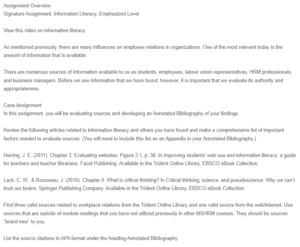Annotated Bibliography – Influences on Employee Relations
Gerich, J. (2023). Prepared for home-based telework? The relation between telework experience and successful workplace arrangements for home-based telework during the COVID-19 pandemic. Journal of Occupational & Environmental Medicine. Vol. 65 Issue 11, p967-975. 9p. https://doi.org/10.1097/JOM.0000000000002948.
The study focuses on the various impacts of home-based telework during the COVID-19 pandemic regarding five workplace relation issues that include social isolation, technostress, work-family conflicts, burnout, and job satisfaction. The study uses a cross-sectional survey of IT, insurance, and finance workers to determine how these aspects are affected by telework workplace arrangements. The findings of the study indicated a negative association between the aspects of home-based telework and a positive association with equipped offices. The source is important for the topic of workplace relations because it assists in understanding better working conditions for improved workplace results.
When considered under the factors highlighted in the appendix, the article was established to be credible, accurate, and reliable. Further, the source serves a specific purpose and is based on a specific timeline of the COVID-19 period. However, it is not clear whether the study is fully objective and free from researcher bias.
Takeda, S., & Fukuzaki, T. (2023). Relationship between turnover intention and workplace personal relations among care workers employed by elder care facilities. Psychogeriatrics. Vol. 23 Issue 1, p86-93. 8p. 3 Charts. https://doi.org/10.1111/psyg.12906.
The study by Takeda & Fukazaki (2023) evaluates factors that influence workplace turnover intentions of workers at the healthcare facilities of the elderly. The study further evaluates the extent to which the turnover intentions are influenced by the factors. In achieving this, the study employs qualitative methodologies to examine workers drawn from the facilities. A total of 406 workers were evaluated, and it was established that female workers were more likely to have workplace personal relations problems than men by 1.97 times. As a result, they developed turnover intentions that are about 2.25 times higher than their male counterparts. Notably, this study is important to workplace relations because it offers insights into how organizational managers should handle turnover intentions among employees.
Subsequently, when evaluated based on the factors highlighted in the appendix section, the study is established to be a credible source with a specific purpose, reliability, and objectivity. However, the source does not indicate a specific target audience and lacks timelines on which it should be based.
van der Put, A. C., Mandemakers, J.J., de Wit, John B. F., & van der Lippe, T. (2021). Actions speak louder than words: Workplace social relations and worksite health promotion use. Journal of Occupational & Environmental Medicine. Vol. 63 Issue 7, p614-621. 8p. https://doi.org/10.1097/JOM.0000000000002196
The study examined colleagues and team managers to establish whether social workplace relations offer insight into the usage of worksite health promotion. Linear probability study methodologies were employed to analyze multi-level data collected from the European Sustainable Workforce Survey. It was established that workers are likely to adopt sports facilities and health menus to achieve a healthy lifestyle. It was concluded that social contact among employees can encourage work health promotion. Essentially, this is a significant contribution to workplace relations, whereby better results are attained from better social contacts among workers. Notably, this work relations research is credible and reliable. Further, it serves a specific purpose. However, it is not based on a specific timeline and does not indicate the place of researcher bias regarding objectivity.
APPENDIX
List of Important Factors to Evaluate Sources
- Purpose of the source
- Intended audience
- Authority of the source
- Source Credibility
- Source accuracy
- Source reliability
- Source currency and timeliness
- Objectivity or bias of the source
ORDER A PLAGIARISM-FREE PAPER HERE
We’ll write everything from scratch
Question
Assignment Overview
Signature Assignment: Information Literacy, Emphasized Level

Annotated Bibliography – Influences on Employee Relations
View this video on information literacy.
As mentioned previously, there are many influences on employee relations in organizations. One of the most relevant today is the amount of information that is available.
There are numerous sources of information available to us as students, employees, labour union representatives, HRM professionals, and business managers. Before we use information that we have found, however, it is important that we evaluate its authority and appropriateness.
Case Assignment
In this assignment, you will be evaluating sources and developing an Annotated Bibliography of your findings.
Review the following articles related to information literacy and others you have found and make a comprehensive list of important factors needed to evaluate sources. (You will need to include this list as an Appendix in your Annotated Bibliography.)
Herring, J. E. (2011). Chapter 3: Evaluating websites, Figure 3.1, p. 38. In Improving students’ web use and information literacy: a guide for teachers and teacher librarians. Facet Publishing. Available in the Trident Online Library, EBSCO eBook Collection.
Lack, C. W., & Rousseau, J. (2016). Chapter 4: What is critical thinking? In Critical thinking, science, and pseudoscience: Why we can’t trust our brains. Springer Publishing Company. Available in the Trident Online Library, EBSCO eBook Collection.
Find three valid sources related to workplace relations from the Trident Online Library and one valid source from the web/internet. Use sources that are outside of module readings that you have not utilized previously in other MSHRM courses. They should be sources “brand new” to you.
List the source citations in APA format under the heading Annotated Bibliography.
Under each source citation, in paragraph form:
Briefly discuss what the source covers and its importance to the topic of workplace relations.
and
Analyze specifically how the factors listed in your Appendix apply to the source (i.e., carefully critique the source using those factors).
Submit your assignment by the module due date.

